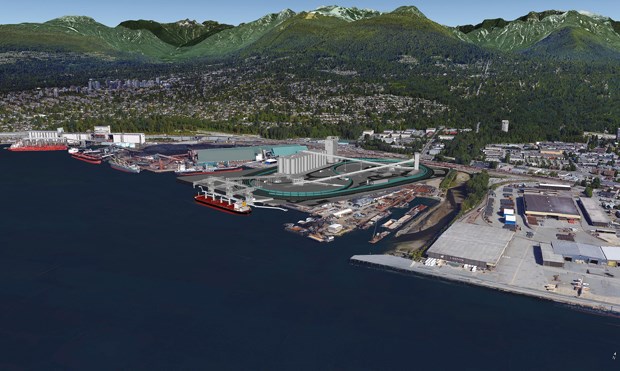Plans for a massive new grain terminal on the North Vancouver waterfront are meeting opposition from residents who say the North Shore is already overburdened with waterfront industry.
“If you research any communities that live in any proximity to a grain terminal, you’re going to find that residents live in a nightmare,” said Holly Cole, a North Vancouver resident who has been leafletting and collecting signatures for an online petition against the project.
Manitoba-based G3 Global Holdings has partnered with Western Stevedoring to build a new terminal at the foot of Brooksbank Avenue, currently home to Lynnterm Westbank. If approved by Port Metro Vancouver, the new terminal would consist of 48 concrete grain silos standing 43 metres (140 feet) tall, plus an overhead conveyor system and a grain cleaning facility that reaches 80 metres (260 ft). The project would also feature a rail loop around the site. At peak operation, it would mean another 168 ships per year departing from the new terminal.
But the project is simply too big and carries with it too many environmental, health and safety concerns, Cole said. Among those concerns: noise and grain dust emanating from the site all day and night, the potential for a terminal explosion, increased shipping traffic on Burrard Inlet and rail traffic coming to the North Shore, view impacts from the “humongous” terminal on the waterfront, plus the impact three years construction would have on the area.
Cole’s petition has netted almost 300 signatures, though so far she’s found most people aren’t aware of G3’s plans. With Richardson International, Cargill Canada and Neptune Terminals already on the waterfront, Cole said most people have said “enough is enough.”
“We try to live well with the port. We try to make it all work, all of us, but to add this huge, highly mechanized facility that will run 24/7 with external moving parts and three huge trains coming in per day, it’s too much to ask,” she said. “There must be other things that could go down there that would be an economic boost to the North Shore and people who live here, besides these great big, ugly 48 concrete grain silos.”
G3 estimates it will employ 50 people when up and running.
“That’s no more hiring than a medium-sized grocery store,” Cole said.
Terrence Loychuk agreed, arguing most of the benefits of the project will fall to the Prairies. “I understand that it’s good for Manitoba, it’s good for Saskatchewan and it’s good for Alberta in terms of their agricultural output but we’re the ones that pay the price,” he said.
Both are asking G3 and Port Metro Vancouver to hold a public meeting for residents to air their concerns and have their questions answered publicly.
But G3’s planned terminal is quite unlike the ones North Vancouver residents are used to at Cargill and Richardson, said Brett Malkoske, vice-president of business development for G3, and it shouldn’t produce nearly as much noise and dust. Because of the rail loop, there will be minimal need for shunting train cars and the machinery on site would be quieter than what exists on the North Shore now.
“It will be difficult for most people to pick up the change in any noise disturbance as anything significant,” he said.
Dust output too should be significantly less thanks to more modern design, Malkoske added.
“We’ve incorporated a lot of best practice in terms of dust mitigation techniques – covered conveying systems, at any points of major dust generation there are filters and dust collectors. We even have incorporated telescoping ship loading systems,” he said. “This is a new standard that doesn’t exist today in the port.”
Malkoske said he encourages everyone to submit their thoughts on the project at g3terminalvancouver.ca. The deadline for input is Feb. 1.
G3 will have to apply to Metro Vancouver for an air quality permit. Residents and public health agencies can also express their concerns as part of the process. The proponent will have to supply a dispersion model plan showing what the expected behaviour of the dust is, and Metro Vancouver will have the ability to impose conditions to mitigate risks to air quality.
“We have pretty stringent air quality objectives in Metro Vancouver. We have pretty good air. Our air usually meets these objectives but we also have some of the tightest objectives in North America,” said Ray Robb, district director.
Port Metro Vancouver provided a statement from vice-president of planning and operations, Peter Xotta, saying the port will consider its mandate to facilitate trade as well as local and environmental concerns.
“Port Metro Vancouver will carefully review all required materials, input, and consultation. Any mitigation strategies to protect the environment or address community impacts, if necessary, will be identified through the port authority review process,” he said.



